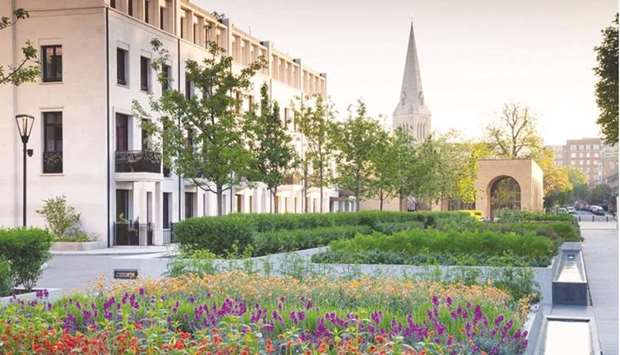Qatari Diar's project (Chelsea Barracks) in London has been awarded LEED Platinum certification for sustainable green buildings, which confirms that the project meets the sustainability standards that were from the beginning a major determinant in the development of the master plan of the project.
Qatari Diar explained that LEED Platinum is the most internationally recognised standard certification for achieving sustainability and leadership, and the Chelsea Barracks project is considered one of the most important real estate development projects in central London as it combines the latest in contemporary technology in a historical environment in addition to being the most sustainable project in Europe. With this certificate, this development project becomes one of 16 development projects in the world that reaches this standard.
It added that the project took into account the actual needs of the population and the local community, in addition to putting long-term sustainability criteria into account when developing the project, which is currently considered a highly important added value for modern housing unit buyers who are looking for unconventional styles amid the hustle and bustle of London.
Head of development and project delivery at Qatari Diar (Europe and America) Tariq al-Abdullah said sustainability is an essential component of the Chelsea Barracks project. It was one of the main considerations in planning and implementing the master plan.
He expressed his pride in obtaining the LEED Platinum certification as the first development project in Europe to obtain this certificate.
Henry Square, co-founder of Square and Co., said the Chelsea Barracks project is the first project in Europe to obtain LEED Platinum certification, and that this project paved the way for the integration of sustainability with the master plans of cities and projects, "and the accreditation process with which we contributed to the application of sustainable development ideas and practices in all aspects of the master plan and building design, including modern planning of streets to ensure easy accessibility, inclusion of green spaces in them, provision of open spaces and ensuring the presence of biological diversity in an integrated ecosystem, in addition to many other things that lead to improvement of air quality and the environment".
Qatari Diar explained that LEED Platinum is the most internationally recognised standard certification for achieving sustainability and leadership, and the Chelsea Barracks project is considered one of the most important real estate development projects in central London as it combines the latest in contemporary technology in a historical environment in addition to being the most sustainable project in Europe. With this certificate, this development project becomes one of 16 development projects in the world that reaches this standard.
It added that the project took into account the actual needs of the population and the local community, in addition to putting long-term sustainability criteria into account when developing the project, which is currently considered a highly important added value for modern housing unit buyers who are looking for unconventional styles amid the hustle and bustle of London.
Head of development and project delivery at Qatari Diar (Europe and America) Tariq al-Abdullah said sustainability is an essential component of the Chelsea Barracks project. It was one of the main considerations in planning and implementing the master plan.
He expressed his pride in obtaining the LEED Platinum certification as the first development project in Europe to obtain this certificate.
Henry Square, co-founder of Square and Co., said the Chelsea Barracks project is the first project in Europe to obtain LEED Platinum certification, and that this project paved the way for the integration of sustainability with the master plans of cities and projects, "and the accreditation process with which we contributed to the application of sustainable development ideas and practices in all aspects of the master plan and building design, including modern planning of streets to ensure easy accessibility, inclusion of green spaces in them, provision of open spaces and ensuring the presence of biological diversity in an integrated ecosystem, in addition to many other things that lead to improvement of air quality and the environment".

